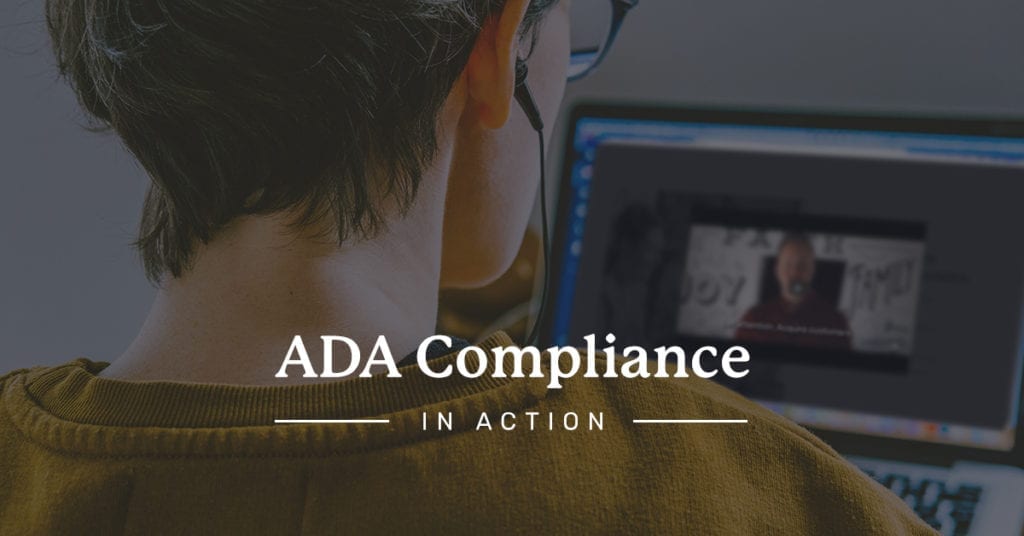If the term “ADA compliance” sounds familiar to you, that’s probably because it’s gotten a lot of attention lately. Unfortunately, it’s mostly been negative attention brought about by the filing of endless ADA website-accessibility lawsuits, with thousands of people suing businesses for websites that are inaccessible to those with disabilities.
ADA Compliance Basics: What You Should Know
The Americans with Disabilities Act, which became law in 1990, states: “The ADA is a civil rights law that prohibits discrimination against individuals with disabilities in all areas of public life, including jobs, schools, transportation, and all public and private places that are open to the general public. The purpose of the law is to make sure that people with disabilities have the same rights and opportunities as everyone else. The ADA is divided into five titles (or sections) that relate to different areas of public life.”
The phrase that became the catalyst for compliance is in Title III, which houses the scope of the definition of “place of public accommodations.” In this section, it says that private businesses must make “reasonable modifications” to serve those with disabilities. It also requires these entities to take necessary steps to communicate with customers who have visual, hearing, motor, and cognitive disabilities. This law is being enforced by the Department of Justice.
It’s a little confusing, though, because there’s no current definitive standard or law directed at website accessibility. But in today’s technological world, judges have regularly identified websites as “places of public accommodations,” so they hold online businesses accountable to the law just as they would a brick and mortar location.
What does that mean for your business?
Well, if you have a website (and it’s 2020… you should!), it needs to be an ADA compliant website, one that’s accessible to those with disabilities. If it’s not, you’re putting yourself at risk of a lawsuit. At the same time, you’re missing out on a lot of business and leaving out many people who want to access your product or service, but can’t.
Lawsuits & People
As a business owner, you don’t think, “I’d love to get hit with an ADA website-accessibility lawsuit.”
What you do think is, “I absolutely do NOT want to deal with an ADA website-accessibility lawsuit.”
And we get it.
ADA website compliance can be complicated. If you identify as a Title III entity, then you’re not “required to be compliant,” but you’re “obligated to comply.” Do you see a difference? Me either.
So how can you ensure ADA compliance on your website and avoid a lawsuit?
It’s really simple: Update your website!
The Web Content Accessibility Guidelines (WCAG) provide acceptable accessibility for those with disabilities that limit their ability to navigate and read websites.
If you’re worried about having an ADA compliant website, then at the bare minimum, that’s what you should follow.
New York-based lawyer Joseph Mizrahi works at a leading firm for ADA website-accessibility lawsuits, and he’s made it clear why businesses should have ADA compliant websites. In one interview, he explained, “We have many clients and, over the course of their lives, they have visited many websites that they cannot access, and they want to enjoy the internet just like anybody else does.”
People with disabilities are people, and they deserve to enjoy access to products and services on the internet just like those without disabilities. Makes sense. And really, who can argue with that?
Improve Your Website Accessibility Today Because, After All, There’s No Better Time Than the… Pandemic?
At Business Builders, we believe everyone should have access to the things they need online, including those with disabilities. That’s why we provide ADA website compliance services that help businesses improve their website accessibility for all while saving themselves from headaches and legal fees.
ADA compliance isn’t just the right thing to instate for those with disabilities, but it’s the best thing to instate for your business’s success, too. In today’s current climate — you know, a global pandemic, where online ordering has skyrocketed — there’s really no better time than the present to update your website to reflect ADA compliance and benefit all involved.
Take the first step toward making your website ADA compliant today and get a free ADA compliance scan.









